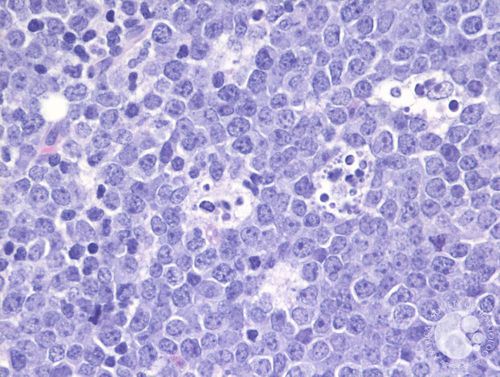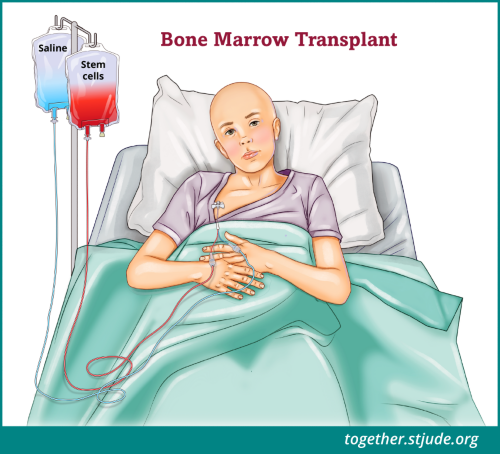What is Burkitt lymphoma?
Burkitt lymphoma is cancer that begins in the cells of the lymphatic system or lymph system. The lymph system is part of the immune system.
Burkitt lymphoma is a type of non-Hodgkin lymphoma (NHL) that starts in the B lymphocytes, which normally help fight infection and disease. This cancer may form in almost any location in the body, but common sites include the lymph nodes, abdomen, tonsils, bones, bone marrow, and central nervous system.
Burkitt lymphoma is usually treated with chemotherapy along with immunotherapy. Survival rates for this cancer in the United States are above 90%.
Symptoms of Burkitt lymphoma
Risk factors of Burkitt lymphoma
Risk factors may increase your child's chances of getting a disease. Little is known about the specific risk factors for Burkitt lymphoma in children. General risk factors for lymphoma are:
- Weak immune system after a bone marrow or solid organ transplant
- Infection with Epstein-Barr virus or human immunodeficiency virus (HIV)
- A genetic disorder such as ataxia-telangiectasia
- More common in males than females
- More common in White than Black children
Diagnosis of Burkitt lymphoma
A cancer diagnosis requires tests and procedures. The doctor will give your child a physical exam, get information about their medical history, and order tests such as:
See Waiting for Test Results.
If the pathologist finds lymphoma cells in the biopsy sample, the lab will perform more lab tests on the sample. These may include flow cytometry, immunophenotyping, and cytogenetic analysis, if these tests are available.
Types of Burkitt lymphoma
Burkitt lymphoma has 3 main types:
- Sporadic Burkitt lymphoma occurs worldwide. But it is most often found in the United States and Europe. It is more common in children than in adults.
- Endemic Burkitt lymphoma occurs in Africa and New Guinea. It is the most common type of lymphoma in these regions. It often causes jaw tumors. It is linked to Epstein-Barr virus (EBV) infections.
- Immunodeficiency-related Burkitt lymphoma is most often seen in patients with AIDS. It can also happen in people who have weak immune systems or are on certain medicines after a transplant.
Stages of Burkitt lymphoma
If a biopsy shows cancer, the care team will plan treatment based on the cancer stage. Some tumors grow rapidly. So, the doctor must stage the lymphoma as quickly as possible.
To find out the stage of non-Hodgkin lymphoma (NHL), doctors may order more tests such as:
The stage will tell how much cancer is present and if it has spread to other parts of the body.
The International Pediatric Non-Hodgkin Lymphoma Staging System divides the disease into 4 stages:
- Stage 1 and 2 lymphomas are limited-stage disease. The treatment for both stages is similar.
- Stage 3 and 4 lymphomas are advanced-stage disease. The treatment for both stages is similar, but the length of time may be different depending on the stage.
Treatment of Burkitt lymphoma
Burkitt lymphoma can be aggressive in children. Treatment must start as soon as possible. The higher the cancer stage, the more aggressive the treatment.
Treatment depends on the following:
- Type of lymphoma
- Stage of lymphoma
- How well it may respond to treatment
- Available treatments
- Patient age and health
Treatment may include:
As with any treatment, side effects can occur. One problem is tumor lysis syndrome. This happens when cancer cells quickly die and break apart in response to treatment. The doctor will watch your child closely for possible side effects. Speak with the doctor if you have questions.
Newly diagnosed disease
Treatment depends on several factors. It could include using more than 1 treatment method. This is known as combination therapy. The care team may treat patients with several chemotherapy drugs or chemotherapy and immunotherapy.
Chemotherapy for Burkitt’s lymphoma
Some medicines commonly used to treat Burkitt lymphoma are:
Some patients may also get rituximab. This is a type of immunotherapy. Treatment may take 2–8 months, depending on risk factors.
The amount of chemotherapy given will depend on:
- The stage of Burkitt lymphoma and the location in the body
- The level of lactate dehydrogenase in the patient's blood
Lactate dehydrogenase is an enzyme made by the body as cells grow and use energy. Levels may be higher than normal in some patients with lymphoma due to the rapid growth of the cancer cells.
Relapsed disease
Doctors usually treat relapsed disease with chemotherapy and rituximab, followed by a stem cell transplant. A common chemotherapy plan for relapsed disease is RICE (rituximab, ifosfamide, carboplatin, and etoposide). New targeted therapy strategies are under study. Some patients may be able to take part in clinical trials to test new treatments.
Prognosis for Burkitt lymphoma
Your care team is the best source of information about your child's prognosis. The prognosis depends on a number of factors, including:
- Stage of lymphoma
- Where the disease is located
- Levels of lactate dehydrogenase in the serum from blood
With the addition of immunotherapy to current treatment plans, the chance of long-term survival for Burkitt lymphoma of any stage now is higher than 90%.
Support for Burkitt lymphoma
Coping with a cancer diagnosis and treatment can be stressful for the patient and the family. You may want to talk to a social worker, a psychologist, or another mental health specialist. Learn more about how to talk to your child about cancer.
After treatment, your child's doctor may use imaging tests and exams to watch for recurrence. Childhood cancer survivors should get follow-up care throughout their lives. Some treatments can cause late effects. These are health problems that happen months or years after treatment ends.
After completing treatment, it is important that your child:
- Has regular checkups and screenings by a primary care provider
- Maintains healthy habits to protect their health, including physical activity and healthy eating
- Has a survivorship care plan to share with their health providers, which includes:
- Guidance on health screenings
- Disease risk factors
- How to improve health
Questions to ask your care team


